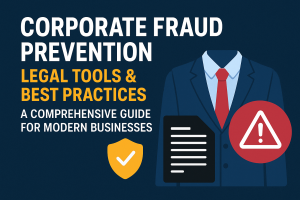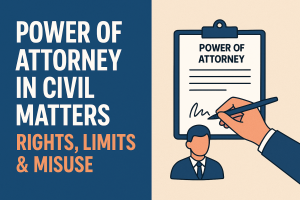When a person is accused of a criminal offence, understanding the seriousness of the charge and the evidentiary elements becomes vital. With the introduction of the Bharatiya Nyaya Sanhita (BNS), Bharatiya Nagarik Suraksha Sanhita (BNSS), and Bharatiya Sakshya Adhiniyam (BSA), the Indian criminal justice framework now requires a sharper understanding of legal classifications, procedural rights, and the kind of evidence that can influence a trial. This article explains the major factors and evidentiary considerations that affect court proceedings in criminal cases.
1. Classification of the Offence under BNS
Under the Bharatiya Nyaya Sanhita, offences are categorised into cognizable and non-cognizable, bailable and non-bailable, and compoundable and non-compoundable. This classification determines how the case is initiated, whether arrest requires a warrant, the right to bail, and whether settlement is possible. Cognizable offences include serious acts such as bodily offences, terrorism, and crimes against the state, where police can arrest without judicial permission. Non-cognizable offences involve less serious conduct and require prior court approval for investigation or arrest. Bailable offences allow the accused to obtain bail as a matter of right, while non-bailable offences give the court discretion. In compoundable offences, the complainant and accused may settle, but in non-compoundable offences, the prosecution proceeds irrespective of compromise.
2. Role of Possession in Criminal Offences
Possession is a critical factor in offences involving narcotic drugs, weapons, counterfeit currency, and stolen property. There are two principal types of possession — physical and constructive. Physical possession refers to the object being found on the person or within their immediate control. For example, if drugs are discovered in a person’s bag or pocket, it qualifies as physical possession. Constructive possession arises when the object is not directly on the person, but the accused has knowledge of its presence and control over its location. An example would be when contraband is stored in a house or vehicle owned or used by the accused. The prosecution must prove both the mental element of awareness and the physical element of control. Under the Bharatiya Sakshya Adhiniyam, possession can be proved by direct evidence or a strong chain of circumstantial facts.
3. Types of Evidence Under BSA
The Bharatiya Sakshya Adhiniyam lays down rules for admitting and evaluating evidence. Documentary evidence includes written contracts, public records, electronic data, and forensic reports. Oral evidence involves witness testimony presented in court. Both forms of evidence must be relevant, material, and admissible under law. Courts closely examine the consistency, credibility, and corroboration of statements made by witnesses. Circumstantial evidence, while indirect, is often decisive when it forms an unbroken and convincing chain linking the accused to the offence. Forensic evidence, such as DNA reports, fingerprint analysis, ballistic examination, and mobile call records, plays an increasingly important role in modern trials.
4. Credibility and Conduct of Witnesses
The success of a criminal trial often depends on the strength and reliability of witness testimony. A witness who contradicts their own earlier statements or who demonstrates bias or lack of clarity may be deemed unreliable. Under the Bharatiya Sakshya Adhiniyam, such inconsistencies can weaken the prosecution’s case or support the defence’s narrative. Courts also consider whether the witness had a proper opportunity to observe the events and whether their version is consistent with the medical and forensic records.
5. Delay and Procedural Lapses Under BNSS
Under the Bharatiya Nagarik Suraksha Sanhita, procedural timelines and rights are strictly codified. Delay in filing a First Information Report or unexplained inaction by the investigating officer can undermine the integrity of the prosecution’s case. If arrest, search, or seizure are carried out in violation of statutory safeguards, the court may exclude the resulting evidence. Judicial scrutiny of procedural fairness is central to a fair trial, and the defence may seek acquittal or discharge on the basis of such lapses.
6. Role of Motive and Mens Rea
Motive and criminal intention form the mental component of many offences. Under the Bharatiya Nyaya Sanhita, proving the mens rea or mental element is essential for convicting someone of offences such as murder, cheating, and criminal breach of trust. If the accused had no clear motive or acted under sudden provocation or mistake of fact, the court may consider this a mitigating factor or may acquit them altogether.
7. Importance of Medical and Expert Evidence
In cases involving bodily harm or death, medical and post-mortem evidence is crucial. If the injuries described by witnesses do not match the medical findings, the court may disregard the oral testimony. Similarly, in cases involving poisoning, gunshot wounds, or sexual assault, expert reports form a key part of the evidentiary structure. The Bharatiya Sakshya Adhiniyam gives these expert opinions significant weight when they are unbiased, objective, and properly submitted.
8. Defence Strategies and Alibi
Accused persons are entitled to present evidence that disproves or contradicts the prosecution’s version. Alibi is one of the most common defences. This involves showing that the accused was at a different location when the crime occurred. Courts assess documentary proof such as location data, digital records, or testimony from credible witnesses. In appropriate cases, the court may also entertain plea bargaining, especially for first-time offenders or lesser offences under the BNS.
9. How Legal Representation Shapes Case Outcome
The role of legal counsel is vital from the pre-trial stage to final argument. A trained advocate can guide the accused in safeguarding procedural rights, securing bail, identifying weaknesses in the investigation, and preparing a well-structured defence. Legal advice is particularly important when dealing with cases involving search and seizure, custodial statements, and forensic analysis. With the introduction of structured procedures under BNSS and technical admissibility norms under BSA, a strategic approach led by a legal professional is crucial for effective representation.
10. Why Understanding Evidence and Procedure Isn’t Enough — The Real Advantage of Having a Criminal Defence Advocate on Your Side
When facing criminal charges, it’s natural to turn to online research for answers — to understand the offence, the evidence required, and possible penalties under laws like the Bharatiya Nyaya Sanhita (BNS), Bharatiya Nagarik Suraksha Sanhita (BNSS), and Bharatiya Sakshya Adhiniyam (BSA). While this self-awareness is valuable, it is not a substitute for legal representation. What truly makes the difference in a court of law is how evidence is challenged, how procedural lapses are exposed, and how your rights are safeguarded at every stage. A criminal defence advocate does not just interpret the law — they apply it strategically, protect you from coercive procedures, ensure bail or anticipatory protection, and build a defence that responds to both facts and law. At Narendra Madhu Associates, we combine legal knowledge with courtroom experience to give your case the best possible direction, right from the first hearing to final judgment.
Conclusion
The outcome of a criminal case depends on multiple factors including the classification of the offence, the nature and admissibility of evidence, procedural compliance by law enforcement agencies, and the strategic choices made by the accused and their legal team. The legal framework under the Bharatiya Nyaya Sanhita, Bharatiya Nagarik Suraksha Sanhita, and Bharatiya Sakshya Adhiniyam ensures structured and fair processes, but navigating them requires sound legal understanding. At Narendra Madhu Associates, we assist individuals in understanding their rights, building a robust defence, and ensuring that every aspect of their case is handled with legal precision and care.



